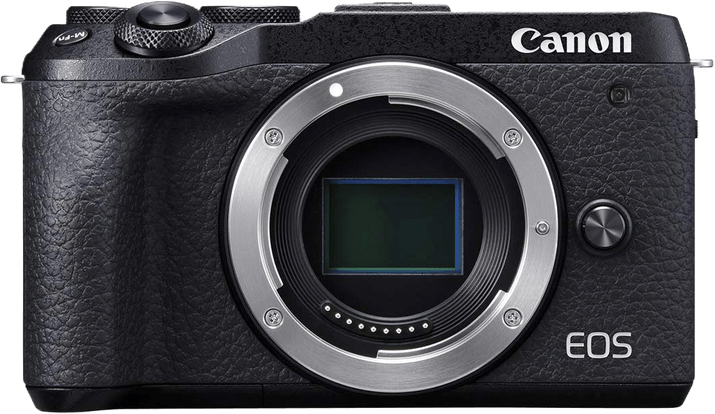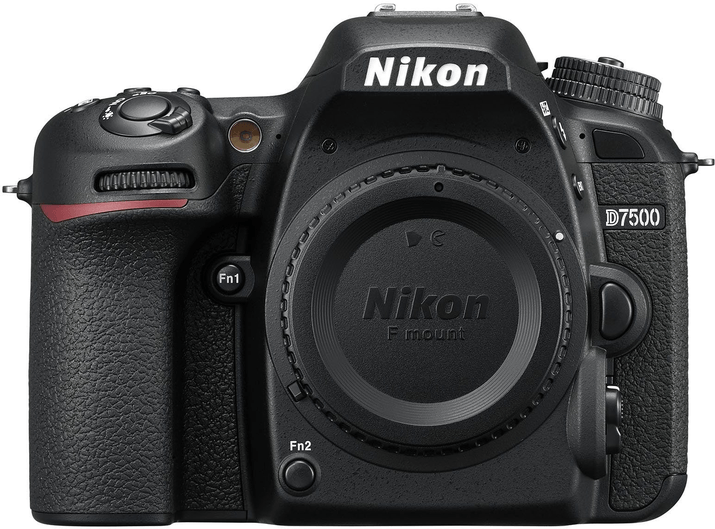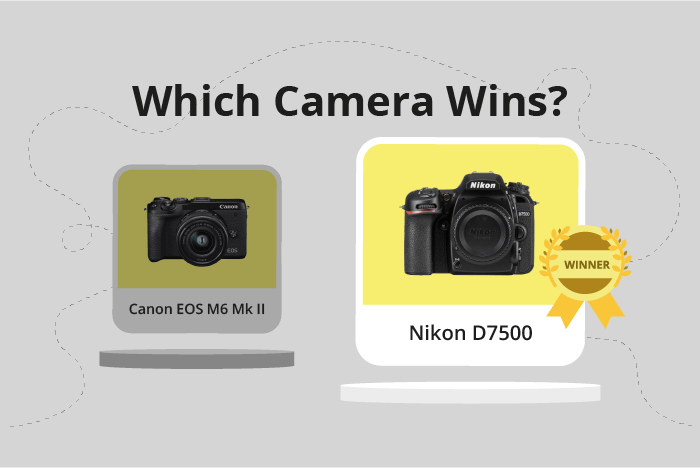Canon EOS M6 Mark II vs Nikon D7500 Comparison
Canon EOS M6 Mark II

Nikon D7500

The Nikon D7500 outperforms the Canon EOS M6 Mark II with a score of 70/100 compared to 63/100. Both cameras were released in 2017 and 2019, respectively, with launch prices of $1250 for the Nikon and $850 for the Canon. They share similarities in their announcement dates, release years, and camera types – the Nikon being a DSLR and the Canon a mirrorless camera.
The Nikon D7500 excels due to its higher score, larger size (136 x 104 x 73mm), and heavier weight (720g). On the other hand, the Canon EOS M6 Mark II has its advantages, such as a lower launch price and a more compact size (120 x 70 x 49mm) with a lighter weight (408g).
Taking these specifications into account, the Nikon D7500 emerges as the superior camera, while the Canon EOS M6 Mark II offers a more budget-friendly and portable option.
Canon EOS M6 Mark II vs Nikon D7500 Overview and Optics
The Nikon D7500 outperforms the Canon EOS M6 Mark II in optics with a score of 68/100, a 6-point lead over the Canon’s 62/100. Both cameras share common specifications, such as CMOS sensor type, APS-C sensor size, and the absence of image stabilization. However, they differ in several key aspects that contribute to the Nikon’s superior optics score.
The Nikon D7500 boasts a higher DXOMARK sensor score of 86 compared to the Canon EOS M6 Mark II’s score of 58. This higher score means the Nikon’s sensor provides better overall image quality, specifically in terms of dynamic range, color depth, and low-light performance. Additionally, the Nikon D7500 uses the Expeed 5 processor, which helps deliver faster and more accurate image processing than the Canon’s Digic 8 processor.
On the other hand, the Canon EOS M6 Mark II has a higher megapixel count of 33, compared to the Nikon D7500’s 20.9 megapixels. This means the Canon can capture more detailed images, which is particularly beneficial for landscape and studio photography. Furthermore, the Canon EOS M6 Mark II offers a faster shooting speed of 14 frames per second, doubling the Nikon D7500’s 8 frames per second. This makes the Canon more suitable for capturing fast-moving subjects or action photography.
The lens mount compatibility is another point of difference, with the Canon EOS M6 Mark II using the Canon EF-M mount and the Nikon D7500 using the Nikon F DX mount. This distinction affects the range of lenses available for each camera.
Considering the optics comparison, the Nikon D7500 emerges as the stronger contender due to its superior sensor performance and image processing capabilities. However, the Canon EOS M6 Mark II’s higher megapixel count and faster shooting speed make it a worthy option for specific photography needs. The choice between these two cameras ultimately depends on the individual photographer’s requirements and preferences.
Canon EOS M6 Mark II vs Nikon D7500 Video Performance
The Canon EOS M6 Mark II outperforms the Nikon D7500 in video capabilities, scoring 91/100 compared to the Nikon’s 70/100. Both cameras share some common specifications, such as 4K video resolution, maximum video dimensions of 3840 x 2160, and built-in time-lapse functionality. However, the Canon EOS M6 Mark II surpasses the Nikon D7500 in several aspects.
The Canon EOS M6 Mark II boasts a higher maximum video frame rate of 120fps, which is significantly better than the Nikon D7500’s 30fps. This higher frame rate allows the Canon camera to capture smoother, more detailed slow-motion footage, providing an advantage for videographers who require this feature.
On the other hand, the Nikon D7500 does not offer any significant advantages over the Canon EOS M6 Mark II in terms of video capabilities. Both cameras share the same video resolution and built-in time-lapse functionality, but the Nikon falls short in its maximum video frame rate.
Considering the differences in video capabilities, it is evident that the Canon EOS M6 Mark II is the superior choice for those prioritizing video quality and performance. The higher video score and maximum video frame rate make it a more versatile and powerful option for videographers. While the Nikon D7500 is still a competent camera, it does not surpass or match the Canon EOS M6 Mark II in video performance.
Canon EOS M6 Mark II vs Nikon D7500 Features and Benefits
The Nikon D7500 wins the features comparison with a score of 83/100, while the Canon EOS M6 Mark II scores 70/100. Both cameras share several specifications, including a touchscreen, flip screen, lack of GPS, and connectivity options like WIFI and Bluetooth.
The Canon EOS M6 Mark II has a 3-inch screen with a resolution of 1040000 dots. This camera’s winning aspects include the higher screen resolution, which provides clearer and crisper image previews and better menu navigation. The Canon EOS M6 Mark II’s Bluetooth and WIFI capabilities allow for seamless file transfers and remote camera control.
However, the Nikon D7500 surpasses the Canon EOS M6 Mark II in several aspects. The D7500 has a larger screen size of 3.2 inches, improving the user experience when composing shots and reviewing images. Its feature score of 83/100 indicates that the camera offers more advanced settings and options, catering to a wider range of photography needs. Like the Canon EOS M6 Mark II, the Nikon D7500 also includes Bluetooth and WIFI, ensuring easy connectivity and file sharing.
While the Canon EOS M6 Mark II has a higher screen resolution, the Nikon D7500’s larger screen size and higher feature score make it a better choice for photographers seeking more advanced options and ease of use. Both cameras have their strengths, but the Nikon D7500 emerges as the winner in this comparison due to its versatility and more comprehensive set of features.
Canon EOS M6 Mark II vs Nikon D7500 Storage and Battery
The Nikon D7500 wins the storage and battery comparison with a score of 43/100, while the Canon EOS M6 Mark II scores 35/100. Both cameras have a single memory card slot and accept SD, SDHC, and SDXC cards. However, the Canon EOS M6 Mark II is compatible with UHS-II cards, offering faster write speeds.
The Nikon D7500 has a significantly longer battery life of 950 shots, compared to the Canon EOS M6 Mark II’s 305 shots. This makes the D7500 more suitable for extended shooting sessions without the need to change batteries. The D7500 uses the EN-EL15a battery, while the M6 Mark II uses the LP-E17 battery.
The Canon EOS M6 Mark II has the advantage of USB charging, which allows for convenient charging on-the-go using a power bank or other USB power source. The Nikon D7500 does not offer USB charging.
The Nikon D7500’s superior battery life makes it the better choice for photographers who prioritize endurance in their camera’s battery performance. However, the Canon EOS M6 Mark II’s compatibility with UHS-II cards and USB charging capability may appeal to those who value faster memory card performance and flexible charging options.
Canon EOS M6 Mark II vs Nikon D7500 – Our Verdict
Are you still undecided about which camera is right for you? Have a look at these popular comparisons that feature the Canon EOS M6 Mark II or the Nikon D7500:

